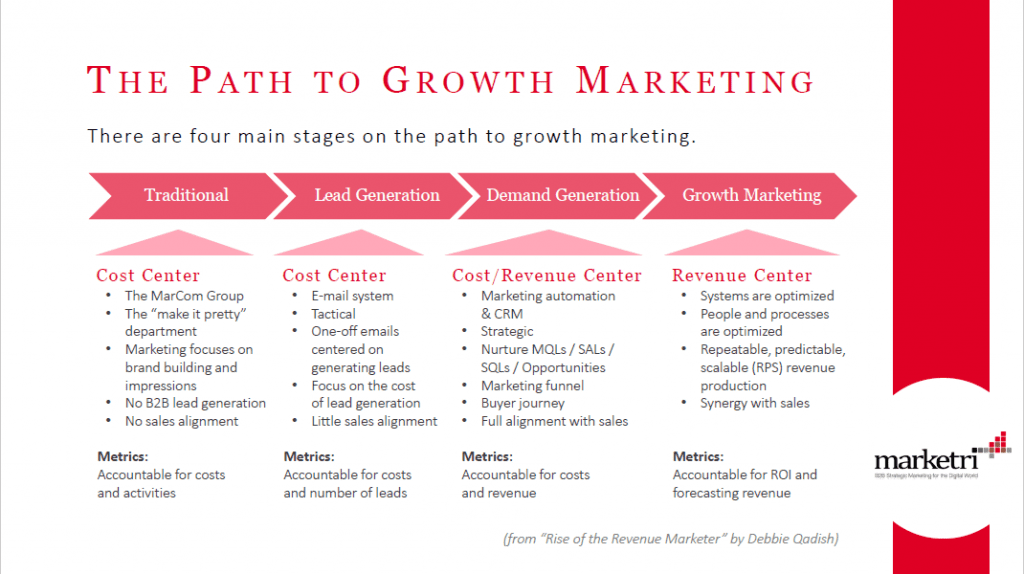7 Steps to Hiring the Right Marketing Talent for Growth

Inbound and outbound; strategic and tactical; specialists and generalists; experienced and recent graduates. The permutations and combinations of marketing positions seem endless in today’s world of modern marketing. At the same time, the stakes have never been higher to acquire the right marketing talent for growth based on where you are in the Profit Center Marketing journey. More than 50 marketing positions – that’s how many different versions of marketing titles I came up with doing a quick scan of the article: Types of Marketing Jobs, Job Titles, and Descriptions. What can an owner or C-level executive do to ensure they have the right combination of in-house and outsourced marketing talent? I suggest they follow these seven steps:
Step 1. Map the Current State
Marketri breaks down the Profit Center Marketing journey in four stages. Companies that are in the demand generation phase will require completely different marketing talent than those at the traditional phase. The first step in acquiring the right marketing talent is to map the current state. Where is your company today?
Step 2. Assess Your Budget
Marketing is not the “make it pretty” department any longer. High-growth companies know that a well-staffed marketing department means lead generation at scale. They are willing to devote substantial resources knowing that a measurable ROI will happen down the road. That said, every company’s budget is different, and it’s important to understand the total marketing budget before acquiring marketing talent. Why is this the case? The funds allocated for marketing must support talent as well as technologies and outreach. A highly experienced CMO can’t accomplish much without working capital. At the same time, a Marketing Coordinator won’t know how to use a million-dollar budget to generate long-term growth.

Step 3. Map the Future State
Given the financial resources available, stick a pin where your company aspires to be within the next 18 months to two years. That journey – from the current state to the future state – offers the insight needed to optimally staff your marketing department. Keep in mind that advancing a full phase in the journey requires a substantial investment in talent and technology and outreach.
Step 4. Develop Your Plan
Many companies hire marketing professionals or assume existing resources can fulfill needs before they have a marketing strategy and plan to guide the current state to the future state. This is the number one reason for turnover among marketing professionals—so don’t do it! Tap your in-house marketing strategist or engage a strategic marketing consultant to create a clear roadmap for the journey within the allocated budget.
Step 5. List Skills Needed
With a marketing plan and budget established, it’s time to list the key skillsets you need. At this stage, don’t try to label positions or determine whether they’re in-house or outsourced. For example, if your current state is lead generation and you want to move to demand generation, the skills required are:
- Marketing Technology (familiar with marketing automation)
- Marketing Strategy (capable of developing the marketing strategy and plan)
- Content Marketing (skilled at all forms of digital marketing content)
- Social Media Marketing (able to drive and opt-in audience and engagement)
- Website / SEO (capable of on-page and off-page SEO and paid search execution)
- Creative Design (familiar with creative for digital collateral and the web)
Step 6: Allocate Hours
For each skillset identified in step four, estimate the number of hours needed each month. Non-marketing executives may struggle with this step, so remember, just a ballpark is fine. In general, you’ll want to determine if it’s a full-time or part-time position. Taking the skillsets from above, I’ve provided estimated hours below.
- Marketing Technology (familiar with marketing automation) – 80 hours
- Marketing Strategy (capable of developing the marketing strategy and plan) – 80 hours
- Content Marketing (skilled at all forms of digital marketing content) – 160 hours
- Social Media Marketing (able to drive and opt-in audience and engagement) – 40 hours
- Website / SEO (capable of on-page and off-page SEO and paid search execution) – 40 hours
- Creative Design (familiar with creative for digital collateral and the web) – 20 hours

Step 7: Label Positions and Acquire!
With the key skillsets identified and estimated monthly hours needed, try combining complementary skills and determine whether the position is full-time or part-time and best served as an in-house or outsourced resource. Here’s what I would recommend with our current example:
- Marketing Technology + Social Media Marketing + Website / SEO: Digital Marketing Director (In-house, Full-time 160 hours)
- Content Marketing: Content Marketing Manager (In-house, Full-time 160 hours)
- Marketing Strategy: Fractional CMO (Outsourced 80 hours)
- Creative Design: Graphic Designer (Freelance, outsourced 20 hours)
Now you’re ready to acquire the right marketing talent for the Profit Center Marketing journey ahead!
A Note About Existing Talent
The elephant in the room that I didn’t address is how to account for existing marketing talent without the needed skillsets. The answer depends on each marketing professional’s ability to be flexible and learn. It also depends on the company’s willingness to invest in their existing professional(s), knowing that the journey may be slower. For companies struggling with what to do with their current marketing staff, a Fractional CMO may be helpful in evaluating existing talent and their readiness for the growth journey ahead.
Want to Learn More?
Marketing talent is one of the four pillars of profit center marketing. If you’d like to get more insight into growth marketing and marketing strategy, then we invite you to subscribe to our blog for updates! You can also download out guide about structuring a marketing department below to learn more about marketing department structure.
Check out these recent insights from our subject matter experts.
Featured Photo by CHU TAI on Unsplash






